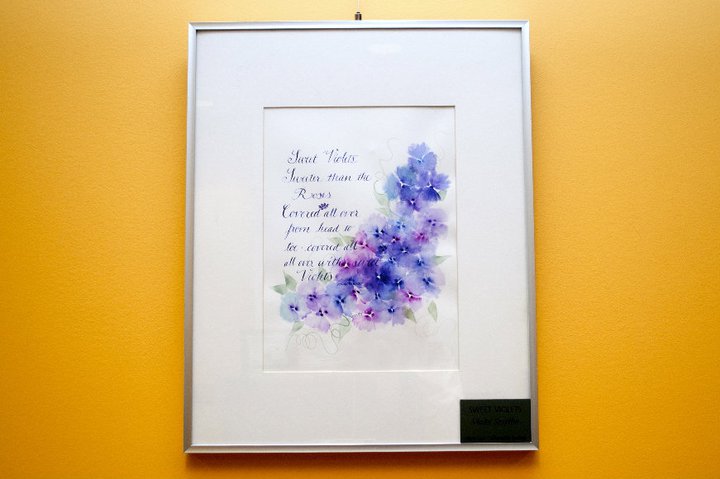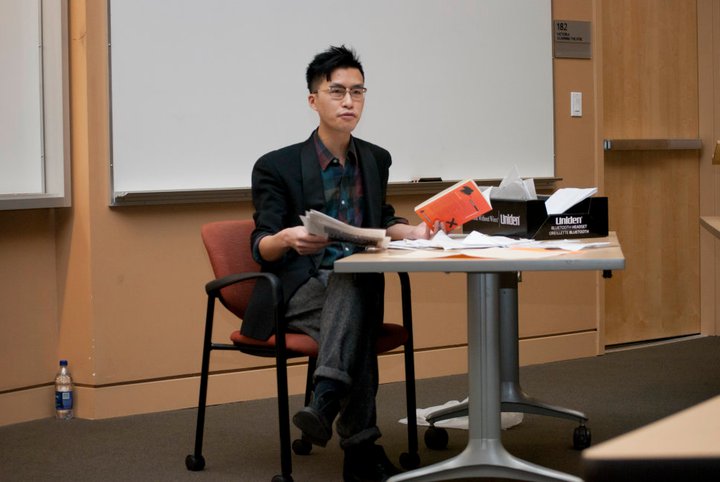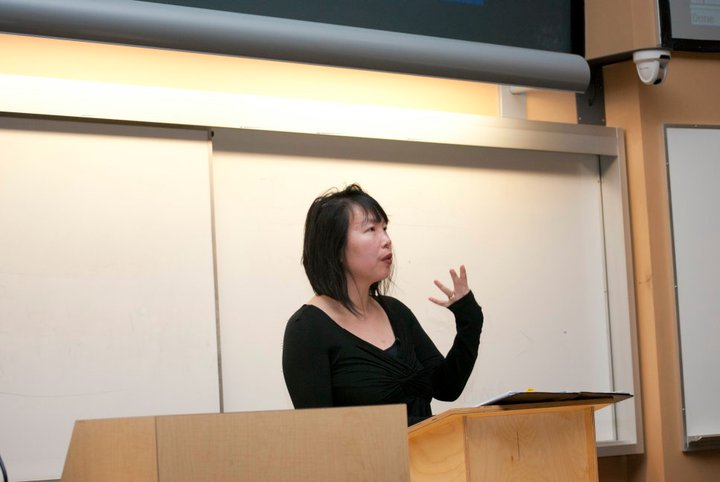
From the Westcoast Calligraphy Society “Letters to the Garden” is a design of colour, illustration, bookbinding, and paper making for everyone interested in the art of letters – with the theme of “Springtime” and “Gardens.” “Letters to the Garden” is a travelling exhibition that has been displayed throughout the lower mainland, including Cloverdale Library and Fleetwood Public Library in Surrey, and the Kay Meek Centre in West Vancouver, B.C. This exhibit at IKBLC can be seen in Learning Centre foyer and Ike’s Cafe Gallery.
IKBLC Gallery Presents "Letters To the Garden"
Larry Goldenberg – Men's Health: Connecting the Dots
On March 2, 2011, Dr. Larry Goldenberg, an award-winning Canadian researcher, pioneer in the treatment of prostate cancer and world-renowned advocate of patient education. Dr. Goldenberg authored one of the first books to explain prostate cancer treatment options in layman’s terms. The Intelligent Guide to Prostate Cancer: All You Need to Know to Take an Active Part in Your Treatment is widely considered to be one of the best resources available to men diagnosed with the disease. Dr. Goldenberg talks about how the 21st century will be a century of aging, and how the Men’s Health Initiative will help people not only live long, but live healthy.
Faculty Research Publications
Goldenberg, S. Larry, Ian M. Thompson, and Carol Glegg. Intelligent Patient Guide to Prostate Cancer: All You Need to Know to Take an Active Part in Your Treatment. Gordon Soules Book Pub, 2001. [Available at BMB LIBRARY (VGH) stacks- Call Number: WJ752 .G64 2001]
Goldenberg, S. Larry, Ian M. Thompson, and Carol Glegg. Intelligent Patient Guide to Prostate Cancer: All You Need to Know to Take an Active Part in Your Treatment. Gordon Soules Book Pub, 2001. [Available at WOODWARD LIBRARY stacks – Call Number: WJ752 .G64 1997]
Goldenberg, Larry. (2005). Further fine tuning of hormone therapy. The Journal of urology, 174(2), 415-416. [Link to journal article]
Akakura, Koichiro, Nicholas Bruchovsky, Goldenberg, Larry, Paul S. Rennie, Anne R. Buckley, and Lorne D. Sullivan. “Effects of intermittent androgen suppression on androgen‐dependent tumors. Apoptosis and serum prostate‐specific antigen.” Cancer 71, no. 9 (1993): 2782-2790. [Link to journal article]
Are you interested in more about this area? There are open access resources available online selected by UBC Librarians
PubMed – Premier database containing over 23 million references to journal articles in life sciences with a focus on biomedicine.
MedlinePlus (Consumer Health) – Freely-searchable consumer health information site linking to simple overviews, dictionaries, directories, organizations and news for ~750 topics.
HLWIK International – HLWIKI International was created in 2006 as a tool to support LIBR 534: Health Information Sources and Services at the School of Library, Archival and Information Studies (SLAIS) at the University of British Columbia. It encourages all professional health librarians and professionals to participate.
Questions for discussion
What is the biggest social barrier to people getting diagnosed?
What do you think is the best educational tool, in terms of prostate cancer education?
Do you think Movember is effective in closing the social barrier/taboos surrounding prostate cancer?
What sparked your interest in prostate cancer?
Useful online resources
Prostate Cancer Canada – http://www.prostatecancer.ca/
U.S. National Library of Medicine – Prostate Cancer – http://www.ncbi.nlm.nih.gov/pubmedhealth/PMH0001418/
Canadian Cancer Society – Information, Diagnoses and Treatments
Prostate Cancer Foundation – http://www.pcf.org
MedicineNet, Inc. – Owned and Operated by WebMD and part of the WebMD Network – http://www.medicinenet.com/prostate_cancer/article.htm#_Toc498458212
What Are Some UBC Resources That Might Be Helpful for understanding Prostate Cancer?
Prostate cancer methods and protocols edited by Pamela J. Russell, Paul Jackson, and Elizabeth A. Kingsley [UBC online resource]
Challenges in prostate cancer edited by Winsor Bowsher and Adam Carter [UBC Woodward Library – WJ752 .C493 2006]
Prostate cancer edited by Marc S. Ernstoff, John A. Heaney, Richard E. Peschel [UBC Woodward Library – WJ752 .P7684 1998]
Prostate cancer: making survival decisions by Sylvan Meyer and Seymour C. Nash [UBC Woodward Library – WJ752 .M494 1994]
For more information, please contact Allan Cho
Ingrid Parent – Fast forward: 21st century libraries in a global context
Webcast sponsored by the Irving K. Barber Learning Centre and hosted by the School of Library, Archival, and Information Studies (SLAIS) colloquium series. In today’s changing information society, knowledge curation is in demand, information literacy is essential, and those entering the workforce must be ready to demonstrate new competencies. No doubt, the library is a force of change, contributing to and accelerating the ever growing needs of e-research. Yet libraries can do more. Libraries need to shift their paradigm from “They will come” to “We will go to them” and in doing so, be prepared to explore new methods of outreach and community engagement at a local level and beyond. How do we, as librarians and information professionals, meet these demands? What trends are libraries currently facing that will impact future generations of information professionals? This presentation will address these key issues and offer a review of libraries and librarianship in a global context.
Ingrid Parent was the 14th University Librarian at the University of British Columbia. Ms. Parent assumed leadership of the UBC Library on July 1, 2009, shortly after winning an award from the Canadian Association of Research Libraries for Distinguished Service to Research Librarianship. She is also President-elect of IFLA and will serve as president from 2011-2013. The International Federation of Library Associations and Institutions (IFLA) is the leading international body representing the interests of library and information services and their users. It is the global voice of the library and information profession. Ms. Parent has an honours degree in History and a Masters in Library Science, both from UBC. She has held a variety of positions in the information profession prior to returning to her alma mater, including the role of Assistant Deputy Minister at Library and Archives Canada (LAC).
Select Articles Available at UBC Library
Parent, I. (2000). Fifty years of service to Canadian libraries. National Library of Canada, Marketing and Publishing Services.
Parent, I. (1992). Speaking from — ABSB (acquisitions and bibliographic services). National Library of Canada, Marketing and Publishing Services.
Parent, I. (2000). Canadian bibliographic centre: The more things change, the more they stay the same. National Library of Canada, Marketing and Publishing Services.
Parent, I. (1999). International conference on national bibliographic services: A truly international experience. National Library of Canada, Marketing and Publishing Services.
UBC Library Research Guides
Westcoast Calligraphy Society – Letters to the Garden
 The Westcoast Calligraphy Society’s “Letters to the Garden” is an exhibition with a theme of spring-time and gardens. With different designs of colour, illustration, bookbinding, and paper making, within the mutual interest in the art of letters, “Letters to the Garden” was a travelling exhibition that has been displayed throughout the lower mainland, including Cloverdale Library and Fleetwood Public Library in Surrey, and the Kay Meek Centre in West Vancouver, B.C.
The Westcoast Calligraphy Society’s “Letters to the Garden” is an exhibition with a theme of spring-time and gardens. With different designs of colour, illustration, bookbinding, and paper making, within the mutual interest in the art of letters, “Letters to the Garden” was a travelling exhibition that has been displayed throughout the lower mainland, including Cloverdale Library and Fleetwood Public Library in Surrey, and the Kay Meek Centre in West Vancouver, B.C.
The Society began life in September 1978 as the Society for Italic Handwriting, B. C. Branch. As the Society grew and its members’ interests expanded, the focus broadened to all types of calligraphy and in June 1986, the name was changed to Westcoast Calligraphy Society. The society is an enthusiastic group of people with a common bond–a love of all things calligraphic. Members share knowledge of design, colour, illustration, bookbinding, paper making and our other talents with everyone interested in the art of letters with more experienced members teaching beginning and more advanced calligraphy throughtout the Lower Mainland.
To see photos of this exhibition, please find here.
Evelyn Lau & Ray Hsu
Living Under Plastic represents a major departure from Evelyn Lau’s previous poetry books. Instead of the focus on relationships and emotional damage that has characterized much of her earlier work, this book opens up to explore new subjects: family history, illness, death and dying, consumerism, and the natural world. In a tone that is often elegiac, without ever being maudlin, these poems are steeped in immortality and loss. Haunted by the pull of the past, there is strength of character and a sense of affirmation in all of these poems. While grounded in travel and in place, the tone is surprisingly meditative and contemplative.
Evelyn Lau began publishing poetry at the age of 12; her creative efforts helped her escape the pressure of home and school. In 1985, at age 14, Lau left home and spent the next several years living itinerantly in Vancouver as a homeless person, sleeping mainly in shelters, friends’ homes and on the street. Despite the chaos of her first two years’ independence she submitted a great deal of poetry to journals and received some recognition. A diary she kept at the time was published in 1989 as Runaway: Diary of a Street Kid. The book was a critical and commercial success
Ray Hsu’s Cold Sleep Permanent Afternoon, the follow-up to his award-winning first collection, Anthropy, is the second book in a prospective trilogy that explores the “grammar of personhood.” He has published over a hundred and twenty-five poems in over forty magazines internationally. Ray is an instructor at the Creative Writing Faculty at UBC.
Ray Hsu and Evelyn Lau read at the Victoria Learning Theatre of the Irving K. Barber Learning Centre on Febraury 24, 2011.
Critical Issues in Aboriginal Life and Thought
UBC Continuing Studies collaborates with other members of the UBC community to provide an ongoing series of free lectures, dialogues and debates on topics of interest to the general public – locally, nationally and internationally. The Lifelong Learning Series is held in the fall and winter terms at UBC Robson Square and is sponsored by the Irving K. Barber Learning Centre as part of its webcast collection.
Critical Issues in Aboriginal Life and Thought is a collaboration of the UBC First Nations Studies Program, the First Nations House of Learning, the Irving. K. Barber Learning Centre and UBC Continuing Studies.
In 2010/2011, UBC Robson Square hosted this series of special dialogues on critical issues in Aboriginal Life and Thought, which included:
Restoring the Balance: Aboriginal Women’s Issues in Canada by Beverley K. Jacobs
Lands, Treaties, and Development Strategies by Dr. Sheryl Lightfoot
Contemporary First Nations Art NOW – An illustrated talk with Shawn Hunt, Lori Blondeau and Dana Claxton
Education, Community Initiatives & Mainstream Institutions by Erin Freeland Ballantyne and Dr. Glen Coulthard
Health Information Series with Larry Goldenberg on March 2, 2011
On March 2, 2011, Dr. Larry Goldenberg – director of the Vancouver Prostate Centre and head of the Department of Urologic Sciences at UBC and an award-winning Canadian researcher as a pioneer in the treatment of prostate cancer and world-renowned advocate of patient education, gave a talk at the Irving K. Barber Learning Centre as part of the IKBLC-Woodward Library sponsored Health Information Series.
Dr. Goldenberg’s book, Prostate Cancer: All You Need to Know to Take an Active Part in Your Treatment, now in its third edition, is widely considered to be one of the best resources available to men diagnosed with the disease.
The Q&A Webcast of this event can be viewed here in its entirety: http://tiny.cc/goldenberg
Seats are limited, so please reserve as soon as possible for this opportunity!
Wednesday March 2, 2011 – 4:30pm -5:30pm
Chilcotin Board Room (Rm 256) at the Irving K. Barber Learning Centre
To ensure a seat, please RSVP in advance: 604.827.4366 or ikblc-events@interchange.ubc.ca
Presented by the Irving K. Barber Learning Centre
and UBC Woodward Library
Michael Byers – African Leadership on International Human Rights Webcast Online
Webcast sponsored by the Irving K. Barber Learning Centre and hosted by the Africa Awareness Initiative. Dr. Byers’ work focuses on the interaction of international law and politics, particularly with respect to human rights, international organizations, the use of military force, the Arctic, and Canada-United States relations. He has published six books, dozens of academic papers and more than 100 op-ed articles in international newspapers, the Globe and Mail, National Post, Toronto Star and Ottawa Citizen.
Mohamad Tavakoli-Targhi – Islam and the Contest of Faculties in Iran
Global Islam: Past, Present and Future is presented by UBC Continuing Studies, the Department of Asian Studies at UBC, the Irving K. Barber Learning Centre and the Laurier Institution. It is part of UBC Continuing Studies’ Lifelong Learning Series. Mohamad Tavakoli-Targhi is Professor of History and Near & Middle Eastern Civilizations at the University of Toronto. Since 2002 he has served as Editor-in-Chief of Comparative Studies of South Asia, Africa and the Middle East. With Homa Katouzian, he is also coeditor of Iranian Studies. Tavakoli is the author of Refashioning Iran: Orientalism, Occidentalism and Nationalist Historiography (2001) and Tajaddud-i Bumi [Vernacular Modernity] (2003); he has authored numerous journal articles and chapters. Born and raised in Tehran, Tavakoli is the recipient of numerous awards. He was an Iran Heritage Foundation Fellow at the Oriental Institute, University of Oxford (2005), a recipient of the prestigious Iranian Fellowship, St. Anthony’s College, University of Oxford (1998), and Outstanding University Teacher, Illinois State University (2000-2001). He was a Visiting Scholar at the Center for Historical Studies, Jawaharlal Nehru University, New Delhi (1992-93). He is currently working on a visual account of modern Iran, and completing a monograph tentatively titled, “All that was Holy in Iran.”
Select Articles Available at UBC Library
Tavakoli-Targhi, M. (2001). Refashioning iran: Orientalism, occidentalism, and historiography. Houndmills, Basingstoke, Hampshire, UK; New York: Palgrave.
Tavakoli-Targhi, M. (2002). From Patriotism to Matriotism: A Tropological study of Iranian Nationalism, 1870-1909. International Journal of Middle East Studies, 34(2), 217-238. [Link]
Tavakoli-Targhi, M. (1999). Contested memories of pre-Islamic Iran. The Medieval History Journal, 2(2), 245-275. doi:10.1177/097194589900200203. [Link]
Tavakoli-Targhi, M. (1996). Orientalism’s genesis amnesia. Comparative Studies of South Asia, Africa and the Middle East, 16(1), 1-14. doi:10.1215/1089201X-16-1-1. [Link]
UBC Library Research Guides
Dave Montgomery – Dirt: The Erosion of Civilizations
Author David Montgomery has discovered that the three-foot-deep skin of our planet is slowly being eroded away, with potentially devastating results. In this engaging lecture, Montgomery draws from his book ‘Dirt: The Erosion of Civilizations’ to trace the role of soil use and abuse in the history of societies, and discuss how the rise of organic and no-till farming bring hope for a new agricultural revolution. Webcast sponsored by the Irving K. Barber Learning Centre.
Relevant Books and Articles at UBC Library
Montgomery, D. (2014). Blue water ditching. Business & Commercial Aviation, 110(10), 40. [Link]
Montgomery, D. (1972). Air-born new Texas metropolis. City : Review of Urban America, 6(4), 27-231.
UBC Library Research Guides


